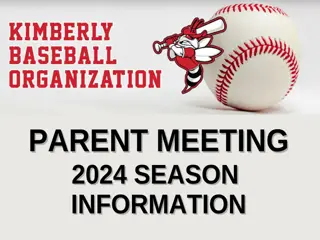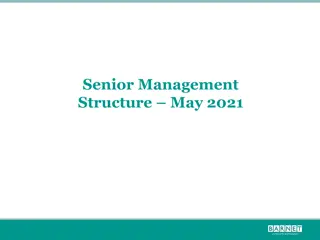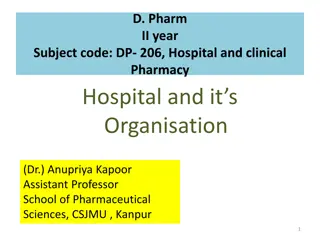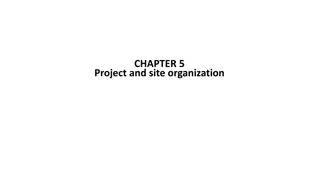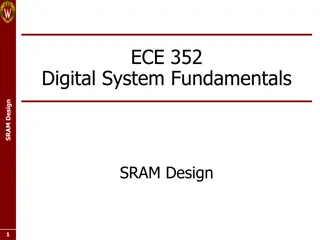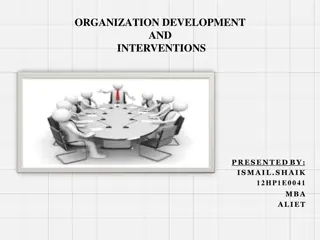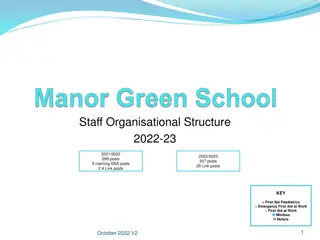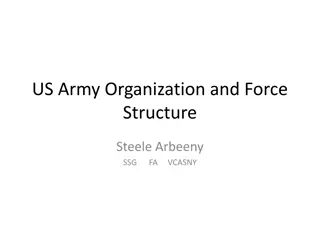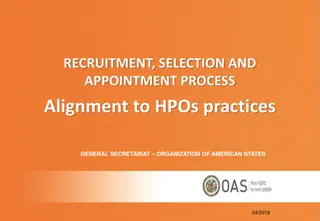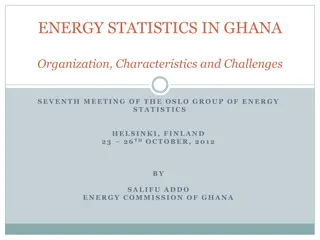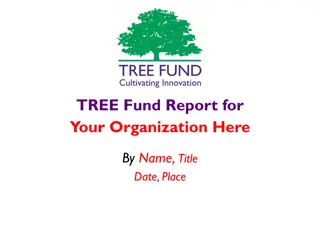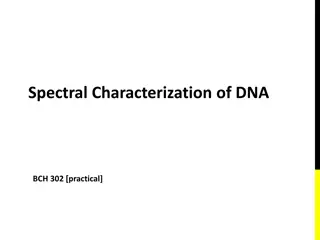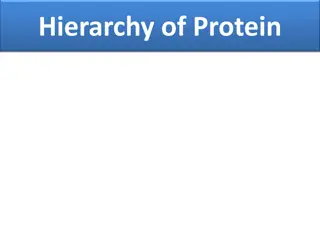Understanding Organization Structure and Process
Organization structure is the formal arrangement of relationships within a firm, important for achieving objectives efficiently. It involves elements like job differentiation, integration, authority systems, and flow of information. The formal and informal organizational structures play distinct roles, with formal structures being deliberate and planned, while informal structures arise spontaneously. Factors like the environment, technology, and psychosocial characteristics influence structure choices. Decentralization can be effective for adapting to local conditions.
Download Presentation

Please find below an Image/Link to download the presentation.
The content on the website is provided AS IS for your information and personal use only. It may not be sold, licensed, or shared on other websites without obtaining consent from the author. Download presentation by click this link. If you encounter any issues during the download, it is possible that the publisher has removed the file from their server.
E N D
Presentation Transcript
Organization Structure It refers to the formal, established pattern of relationships amongst the various parts of a firm or any organization. Organizing is the formal grouping of activities and resources for facilitating attainment of specific organizational objectives. It is possible to achieve objectives organizing, but there is likely to be wastage of resources and time. without formally
Elements of an OS Organization chart & Job Description Differentiation(tasks assigned to different people & departments) Integration (coordinated activities) Authority System(power, status) Administrative system(policies, procedures) Flow of Information & Communication N/W
Formal & Informal Organization The departments, activities, people and their reporting relationships. The informal structure refers to the social groups or friendships which people working together may form. formal structure delineates specific
Formal Vs Informal Organizations Have planned structures Deliberate attempts to create patterned relationships Usually shown by a chart Traditional theory advocates formal organization Not formally planned Arise spontaneously as a result of interactions Not depicted in a chart Human relations theory stresses informal organization
Factors influencing the choice of structure Impact of environment (economic, social, cultural, political, and legal sub-systems) Impact of technology Impact of psychosocial characteristics (demand of leisure time, worker rights)
Degree of Decentralization Centralization refers to the concentration of authority and decision making in one single position in the organization. (Real time information through adaption of technology) Decentralization is effective when conditions in each market are so different that only a high degree of adaption to local conditions will lead to success.
Line (There is a direct relationship of command from superior to subordinate) and Staff(more advisory in nature) Relationships Specialisation of work Scalar principle & Unity of Command Span of Control & Levels of Management
MANAGEMENT Contents Meaning Definition Nature Functions Levels and type of managers Task of a manager Essential managerial skills Managerial roles
Meaning Management is the act of getting things done by a group of people with the effective utilisation of available resources. A minimum of two persons are essential to form a management.
What is Management? Management as key group In-charge of organisational affairs, Making organisation a purposeful and productive entity. Brings together/ integrates the resources. Management as set of functions The functions include Planning, Organising, Directing, Staffing and Control. Determine goals and activities helps in allocation of tasks and resources. Management Management is an influence process to make things happen, to gain command over phenomena, to induce and direct events and people in a particular manner.
Definitions of Managemt John.F.Mee - Management is the act of securing maximum results with a minimum of efforts so as to secure maximum prosperity for the employer and the employee and give the public the best possible service. Henry Fayol - To manage is to forecast and plan, to organise , to command, to co-ordinate and to control. Kreitner - Management is the process of working with and through others to achieve organizational objectives in a changing environment. Central to this process is the effective and efficient use of limited resources.
Definitions of Managemt F.W.Taylor - Management is the art of knowing what you want to do in the best and cheapest way. Koontz and Weihrich - Management is the process of designing & maintaining an environment in which individuals, working together in groups, efficiently to accomplish selected aims.
I. As managers, people carry out the managerial functions of planning, organising, staffing, leading, directing, coordinating and controlling. Management applies to any kind of organization. III. It applies to managers at all organizational levels. IV. The aim of all managers is the same : to create surplus. V. The Management is concerned with productivity ; this implies effectiveness and efficiency. (As Peter Drucker puts it, efficiency means doing things right and effectiveness means doing the right things. II.
Productivity, Effectiveness, and Efficiency Successful companies create a surplus through productive operation. P=(O/I) within a time period, quality considered P can be improved 1. By increasing outputs with the same inputs 2. By decreasing inputs but maintaining the same outputs 3. By increasing outputs and decreasing inputs to change the ratio favorably
P implies effectiveness and efficiency in individual and organizational performance. Effectiveness is the achievement of objectives. Efficiency is the achievement of the ends with the least amount of resources.
What is Management? Management is what managers do. It is the process of getting things done, effectively and efficiently, with and through other people. Efficiency means doing a task correctly ( doing things right ) and getting the most output from the least amount of inputs. Effectiveness means doing the right things by doing those work tasks that help the organization reach its goals. Whereas efficiency is concerned with the means of getting things done, effectiveness is concerned with the ends, or attainment of organizational goals.
Managerial skills and the organizational hierarchy Conceptual skill (deals with ideas and vision) Human skill (cooperative effort & team work of people) Technical skill (methods, processes, and procedures to do a job) Growing Together- If the people working in a company grow, the company s growth will take care of itself. People work for people. Bring out each other s potential; help others. Accept to be challenged and to be helped. Together we grow, Together we can.
Art of Getting Things Done Mary Parker Follett Management is the art of getting things done through others. Harold Koontz Management is the art of getting things done through and with people in formally organized groups. Networking & Teamwork Leverage works. You can achieve 100 times more through a team or network of people than you can do it all by yourself. Teamwork means coming together, working together, achieving more, the ability to direct individual accomplishments towards organizational objectives.
Management as a Process Henry Fayol To manage is to forecast and plan, to organise, to command, to co-ordinate, and to control. Louis Allen Management is what a manager does. Everything has to Planned Month-by-month, day-by-day, minute-by-minute everything has to be planned, nothing happen by accident. As by failing to prepare, you are preparing to fail and if you plan, you can even fly a plane! As it is rightly said, people don t plan to fail, they fail to plan.
ManagementAs A Discipline It is used to connote neither the activity nor the personnel who performs it, but as a body of knowledge, a practice and a discipline. It is treated both as an art as well as science. An art is often regarded as the systematic application of skill or knowledge in effecting accomplishment of results. It is regarded as a science because it has developed certain principles, and techniques which have more or less universal application. science will be meaningless and lifeless, if the art is forgotten.
Natures 1. Management is both an art and a science. 2. Management is an activity. 3. Management is a continuous process. 4. Management achieving pre-determined objectives. 5. Management is a factor of production. 6. Management is needed at all levels. 7. Management aims at maximising profit. 8. Decision-making. 9. management is universally applicable. 10. Direction and control.
Functions 1. Planning- Deciding in advance that which will be done in the near future. 2. Organising- Distribution of work in group wise or section wise for effective performance. 3. Staffing- Staffing refers to placement of right persons in the right jobs. 4. Directing- Directing includes guidance , supervision and motivation of employees. 5. Co-ordinating- The organized group activities are co-ordinated towards the achievement of objectives of an organisation.
6. Motivating- Motivation increases the speed of performance of a work and developing a willingness on the part of the workers. (incentives , fair treatment etc.) 7. Controlling- Ensuring that achieved objectives conform to pre-planned objectives. 8. Innovation- Preparations of personnel and organisation to face the changes made in the business world.(developing new materials, new products , new techniques etc.) 9. Representation- A manager has to act as a representative of the company. 10.Decision-making- It helps in the smooth functioning of an organisation.
Levels of managers The top level managers :- A small group policy makers and their responsibility is to develop the objectives and strategies of the organization. The middle level managers :- Have a number of responsibilities and linking activities. They directs the activities of the first level managers. The first level managers:- Direct contact with the employees,who usually produce goods or service outputs of an organization. They referred to as supervisors or foremen in some organizations.
Task of a manager 1. Maintaining firm s efficiency in terms of profit generation. 2. Meeting the challenge of increasing competition. 3. Managing for innovation. 4. Building human organisation. 5. Sustaining leadership effectiveness. 6. Postponing managerial obsolescence 7. Coping with increasing level of aspiration. 8. Maintaining relations with various society segments.
Managerial skills 1. Planning skills:- Being able to think ahead, Forecast future environmental trends affecting the organisation, State organisational objectives, Choose strategies that will help in attaining these objectives, 2. Organising skills:- Analyse and describe various organisational jobs, Select ,train and induct people in jobs, Define authority and span of control amongst people.
3. Leading skills :- Leading people requires that leader must understand the values, personality, perception and attitudes of these people. These concepts varies from person to person. 4. Controlling skills :- The skills of controlling consists of actions and decisions which managers undertake to ensure that the actual results are consistent with desired results. 5. Decision-making skills :- A manager s effectiveness lies in making good and timely decisions. for any decision the manager have to Identify and define the problem Develop alternative decision Select the decision which will solve the problem and Implement that decision.
Managerial skills at various levels 1. Conceptual skills :- It deals with ideas. Ability to see the organization as a whole recognizing how functions of depend on one another. It requires at the top level. 2. Human skills :- It deals with people. Human skill is the manager s ability to work effectively as a group member and to build cooperative effort within the team he leads. 3. Technical skills :- It deals with jobs. Ability to work with resources in a particular area of expertise. It requires in the lower level. and includes various organization it the the
Managerial roles Henry Mintzberg isolated 10 roles that are common to all managers which grouped in to 3 categories- Interpersonal , informational and decisional roles. 1.Interpersonal roles :- There are three interpersonal role that a manager plays i.e. (a)figurehead (b) leader and (c) liaison.
2. Informational roles :- Every manager is a clearinghouse for information relating to the task at hand. It includes- (a) nerve centre or monitor (b) disseminator and (c) spokesperson. 3. Decisional roles :- In their decisional roles, managers balance competing interests and make choices. Through it strategies are formulated and put in to action. (a) entrepreneurial - set patterns, initiates changes, take calculated risks (b) disturbance handler conflicts both internal & external (c) resources allocator balanced growth and (d) negotiator agreements, terms & conditions with customers, suppliers and other external agencies, trade unions.
Qualities of a Manager (Physical) Impressive Maintained throughout the career Good appearance, Sound health Cheerful disposition(preparation, readiness) Stamina, Posture, Promptness Dress & cleanliness
Qualities of a Manager (Mental) Alertness, Tactful, Ability to judge, Maturity Farsightedness (Knowing well in advance) Initiative, Good decision-maker, Sharp memory Ambitious, Self-confidence, Tolerance, Sincerity, Adaptability, Judgment Dependable (worthy of reliance/trust) Ability to understand & learn Mental vigour (active strength of body & mind)
Qualities of a Manager (Social & Moral) Honesty Good character Willingness to accept responsibility Loyal Integrity Dignity Initiative
Qualities of a Manager (Other) Education Training Communication Relationship management Mentor Special knowledge (peculiar to the function, be it technical, commercial, financial,managerial etc.) Knowledge/Experience arising from the work
Evolution of Management Thought Classical School of Management Thought (1850-1950) (emerged from the Industrial Revolution) CMT is based on the belief that workers only have physical & economic needs. It does not take into account social needs or job satisfaction, but instead advocates a specialization of labor, centralized leadership and decision-making, & profit maximization. It focuses on the efficiency of employees & on improving an organization s productivity through quantitative (i.e., measurable, data driven) methods. Scientific Management (Taylor) Administrative Management (Theory) (Fayol) iii) Bureaucracy (Weber) i) ii)
i)Scientific Management Frederick Winslow Taylor (1885-1915) Father of Scientific Mgmt : The fundamental principles are as follows 1. Replacing rules of thumb with science (organized knowledge) Estimates vs Precise 2. Obtaining harmony in group action, rather than discord. (give & take situation) 3. Achieving cooperation of human beings rather than chaotic individualism.(Mgmt & Workers) 4. Working for maximum output, rather than restricted output. (surplus) 5. Development of workers (scientific training)
ONE BEST WAY OF PERFORMING A JOB (production efficiency, productivity of employees and profits) Time Study (work study in modern management) Functional Foremanship planning should be different from supervisors responsible for execution) Differential Rate System (higher rate for hard work) Routing System (sequence of activities) (Supervisors for
Henry L. Gantt (1861-1919) (task-and-bonus system & Gantt chart) Revised differential price rate system Workers daily work progress rated and publicly displayed Devised chart for production scheduling An effective planning & control technique
Frank & Lilian Gilbreth To reduce worker fatigue(to lose strength or energy), promote efficiency and complete the jobs in less time. Promoting individual worker s welfare. Gilbreth proposed a three-position plan of promotion according to which the employee trains his successor, performs his present job, & prepares for the next highest one in the mgmt hierarchy, all at the same time.
Contribution of Scientific Management Stoner stated the SM not only developed a rational approach to solving organizational problems but also pointed the way to professionalization of management Adoption of SM with division of work and one best way at its core.
Limitations of Scientific Management Mechanistic & impersonal approach (emphasis on production output) Lack of attention to psychological needs (interpersonal relationships among workers were absent) Job monotony Use a device for exploitation (undesirable pressure) Unscientific and antisocial (feared of jobs)
ii) Administrative Management Henri Fayol (1841-1925) a French factory owner & engineer proposed the activities in the organization are: Technical (production) Commercial (purchase & sales) Financial (source and control of capital) Security (protection of property & employees) Accounting(balance sheet, records & costing) Administrative (Planning, Commanding, Coordinating, Controlling) Organizing,
Fayols Principles of Management 1. Division of work 2. Authority & Responsibility 3. Discipline 4. Unity of command(one superior only) 5. Unity of direction(one head one plan for a group of activities having similar objectives) 6. Subordination of individual interest to general interest 7. Fair remuneration to workers
Fayols Principles of Management 8. Centralization 9. Scalar chain(gang plank) 10. Order( a proper place for everything or everything in its right place and a place for everyone and everyone in his appointed place ) 11. Equality 12. Stability of tenure of personnel 13. Initiative(to suggest ideas and new methods) 14. Esprit de corps (Cooperation & team work can bring harmony & unity within the organization. Fayol was against the policy of divide & rule & abuse of written communication )
iii. Bureaucracy (Max Weber) Characteristics of Weberian Bureaucratic model) 1. Division of labour/work 2. Hierarchical structure & authority 3. Rules & Regulations (standardization, equality, and save time & effort) 4. Impersonal conduct 5. Appointment based on competence and not on nepotism 6. Staffing 7. A system of procedures for dealing with situation. (Recorded in writing)
2.Neo Classical School of Management Thought (The Human Relations Approach) Hawthorne Experiment 1. An organization is a social system with a culture of its own. 2. Informal groups have a great impact on workers productivity. 3. There are frequent conflicts between the organization and the individuals. 4. Friendly & liberal supervision has a favorable influence on human efficiency at work.
2.Neo Classical School of Management Thought (The Human Relations Approach) Hawthorne Experiment 5. Free flow of communication in the organization creates cordial relationship & good relations. 6. Non-economic rewards such as praise, status, inter-personal relationships play a crucial role in motivating workers.
Behavioural Science Approach(A.H. Maslow, Douglas McGregor, Frederick Herzberg) It is an interdisciplinary approach (Knowledge) Organization as a social system Individuals differ in terms of personality, belief, attitude, value, perception etc. Informal groups exercise great influences on the attitude, behaviour & performance of the employee. New areas like motivation, leadership, communication, change & development, group dynamics dominate the core concept of management. Workers were treated like human beings instead of machine operators.




